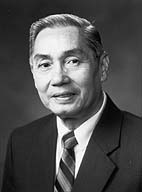“The Church in the Philippines,” Ensign, July 1993, 80
The Church in the Philippines
Life can be hard for the people of the Philippines, with daunting hardships and challenges. But the Church continues to grow steadily there. To learn more about its progress, the Ensign talked with the Philippines/Micronesia Area presidency, Elders Vaughn J. Featherstone, Ben B. Banks, and Augusto A. Lim of the Seventy.



Elder Vaughn J. Featherstone Elder Ben B. Banks Elder Augusto A. Lim
Question: Tell us of the hardships faced by members in the Philippines.
Answer: Natural disasters are a part of life for everyone in the country. A Manila newspaper published a count of natural disasters in countries of the world over a ten-year period. The Philippines had 761, while the next closest country, India, had approximately half that number. In 1991, the eruption of Mount Pinatubo displaced a million people and made headlines around the world. But in addition to volcanic activity, an average of twenty-three typhoons a year strike the Philippines. For example, not long ago a major typhoon struck in one area in the islands yet didn’t even make the headlines in Manila because of a simultaneous volcanic eruption.
Poverty is another serious problem in the Philippines. Some 40 percent of the country’s families are unable to provide for their basic nutritional needs. Children as young as eight or nine can be seen working to help support their families in some places. Homelessness is common. Some garbage collectors clean out their pushcarts at night and sleep in them.
Q.: How do Filipinos manage to surmount their difficulties?
A.: They are a very resilient people. They think of themselves as survivors. Elder Lim, a native of the Philippines, says they may be the happiest people on earth, despite poverty, because they are so grateful for what the Lord grants them.
Q.: Undoubtedly members of our church are not immune to poverty.
A.: No, but part of the strength of our members is that so many of them, whatever their socioeconomic status, understand that they owe everything to the Lord.
And poverty doesn’t stop people from serving. We have many members like the humble family who, while they were investigating the gospel, got up at 2:00 A.M. one Saturday to walk eleven miles to the chapel for a service project. Afterward, they walked home, then got up the next morning to walk back to Sunday meetings.
We feel that one reason for the growth of the Church is the great, great faith of members like these. So many of our members have a deep humility that helps them stay close to the Lord.
Q.: How many members are there in the Philippines now?
A.: Approximately 320,000. It changes rapidly. We have been baptizing about 2,000 people per month. We have 13 missions, 48 stakes, and 72 districts.
The faithfulness of the members is helping to push the work along. Our temple work, for example, has gone up dramatically. The annual number of endowments performed at the Manila Philippines Temple has increased by almost 50 percent over the past four years.
Q.: With the Church growing so rapidly, many leaders must be comparatively young.
A.: It is basically a first-generation Church in terms of general leadership. The average age of our bishops is thirty. We have one regional representative who is in his mid-thirties and has previously served as a bishop and as a stake president. It is a great blessing that among our priesthood leadership, most of them have had the experience that comes from serving missions.
We continually hope for more couples to be called on missions, because they are invaluable. We had one couple responsible for forty baptisms after being out only six months—and the husband had been serving simultaneously as the branch president!
Q.: What do you see for the future of the Church in the Philippines?
A.: We expect that Filipinos will continue to accept the blessings offered by the gospel. The Church is well accepted at every level. We have met twice with the president of the country; a near relative of his is a member who is currently serving a mission in New Zealand. One wealthy member took the opportunity at his fortieth wedding anniversary dinner to tell his friends—many of them members of other faiths—how important temple marriage and gospel blessings are in his life. He was in effect bearing his testimony to a group that included national government leaders and other influential Filipinos.
Throughout the country, thousands are humbly responding to the message of the gospel and changing their lives each year. As long as that spirit is found among them, we expect Church membership to continue to grow in the Philippines.